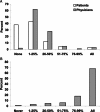Barriers to asthma treatment in the United States: results from the global asthma physician and patient survey
- PMID: 23282317
- PMCID: PMC3651005
- DOI: 10.1097/WOX.0b013e3181c81ea4
Barriers to asthma treatment in the United States: results from the global asthma physician and patient survey
Abstract
Background: : The Global Asthma Physician and Patient (GAPP) survey evaluated the perceptions of both physicians and patients on the management of asthma. Here we present the results from the United States (US) subpopulation of the GAPP survey.
Methods: : The GAPP Survey was a large, global study (physicians, n = 1733; patients, n = 1726; interviews, n = 3459). In the US, 208 adults (aged ≥18 years) with asthma and 224 physicians were recruited. Respondents were questioned using self-administered online interviews with close-ended questionnaires.
Results: : Physician and patient responses were found to differ in regard to perception of time spent on asthma education, awareness of disease symptoms and their severity, asthma medication side effects, and adherence to treatment and the consequence of nonadherence. Comparison of the US findings with the global GAPP survey results suggest the US physician-patient partnership compared reasonably well with the other countries in the survey. Both patients and physicians cited a need for new asthma medication.
Conclusions: : Similar to the global GAPP survey, the US-specific findings indicate that in general there is a lack of asthma control, poor adherence to therapy, and room for improvement in patient-physician communication and partnership in treating asthma.
Figures





Similar articles
-
Unmet needs in asthma: Global Asthma Physician and Patient (GAPP) Survey: global adult findings.Allergy. 2007 Jun;62(6):668-74. doi: 10.1111/j.1398-9995.2007.01352.x. Allergy. 2007. PMID: 17508972
-
Key barriers to optimal management of adult asthma in Australia: physician and patient perspectives.Curr Med Res Opin. 2007 Aug;23(8):1799-807. doi: 10.1185/030079907X210714. Curr Med Res Opin. 2007. PMID: 17597555
-
GAPP Italy: "A survey on asthma on Italian physicians and patients".Eur Ann Allergy Clin Immunol. 2010 Aug;42(4):146-54. Eur Ann Allergy Clin Immunol. 2010. PMID: 21114198
-
Non-adherence in children with asthma reviewed: The need for improvement of asthma care and medical education.Pediatr Allergy Immunol. 2015 May;26(3):197-205. doi: 10.1111/pai.12362. Pediatr Allergy Immunol. 2015. PMID: 25704083 Review.
-
Overcoming barriers to nonadherence in asthma treatment.J Allergy Clin Immunol. 2002 Jun;109(6 Suppl):S554-9. doi: 10.1067/mai.2002.124570. J Allergy Clin Immunol. 2002. PMID: 12063512 Review.
Cited by
-
Barriers to medication use in rural underserved patients with asthma.Res Social Adm Pharm. 2015 Nov-Dec;11(6):909-14. doi: 10.1016/j.sapharm.2014.12.004. Epub 2014 Dec 23. Res Social Adm Pharm. 2015. PMID: 25622993 Free PMC article.
-
ICS/formoterol in the management of asthma in the clinical practice of pulmonologists: an international survey on GINA strategy.Asthma Res Pract. 2021 Jan 29;7(1):1. doi: 10.1186/s40733-021-00067-z. Asthma Res Pract. 2021. PMID: 33514439 Free PMC article.
-
Creating a community-based comprehensive intervention to improve asthma control in a low-income, low-resourced community.J Asthma. 2020 Aug;57(8):820-828. doi: 10.1080/02770903.2019.1619083. Epub 2019 Jun 26. J Asthma. 2020. PMID: 31082287 Free PMC article.
References
-
- GINA: the global initiative for asthma. 2008. Available at: http://www.ginasthma.org/ Accessed May 13, 2009.
-
- Asher MI, Montefort S, Bjorksten B, Lai CK, Strachan DP. et al.Worldwide time trends in the prevalence of symptoms of asthma, allergic rhinoconjunctivitis, and eczema in childhood: ISAAC Phases One and Three repeat multicountry cross-sectional surveys. Lancet. 2006;2:733–743. doi: 10.1016/S0140-6736(06)69283-0. - DOI - PubMed
LinkOut - more resources
Full Text Sources

